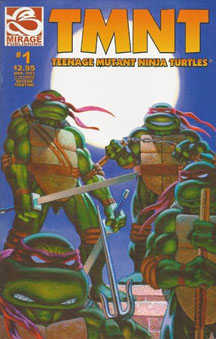Around the turn of the century, Peter Laird bought out Kevin Eastman’s share of the “TMNT” empire and soon got his second wind of interest in telling Turtles stories. According to an editorial in “Teenage Mutant Ninja Turtles” Volume 4, Issue 1 (December 2001), we can thank three passionate fans named Ria, Sarah and Bridgett, whom Laird met at a convention, for re-stoking Laird’s interest.
And what a second wind it turned out to be: Volume 4 has run for 31 issues (with the slim hope of more in the future), and Mirage staffers put out 70 issues of “Tales of the TMNT” Volume 2, plus a four-issue series on each Turtle. That’s 117 issues between 2001 and 2010, just slightly less than the total number of Mirage and Image issues from 1984-99.
Second wind
This second wind for Laird corresponded with the franchise’s second wind; many of the letter writers talk about the upcoming cartoon (2003-09), Playmates toy line, video games and rumors of a CGI movie (the simply titled “TMNT,” in 2007).

“Teenage Mutant Ninja Turtles” Vol. 4 Issues 1-7 (2001-02)
Writer: Peter Laird
Pencils: Jim Lawson
Inks: Peter Laird, Eric Talbot
I never really got into any of that stuff, but since Volume 4 came straight from Laird, and it’s a continuation of the Mirage saga taking place more or less in real time – the Turtles are in their early 30s, and Shadow is a teenager – it’s very much worth a look for fans of mature Turtles fiction.
At the time Volume 4 came out, I didn’t mind that Laird opted to ignore Image’s Volume 3. I had a shallow and incomplete view of Volume 3 being the stories that mutilated the Turtles (Don as a cyborg, Raph with an eye patch, and Leo losing his hand). After recently re-reading and realizing how great Volume 3 is, it retroactively bugs me that Laird ignored it.
But with Andrew Modeen’s Issues 24-25 (2011-12) bridging the gap between the volumes, Laird’s position now bugs me less. Thanks to those wonderful connective episodes – where the Turtles are restored to full health — Laird can ignore Volume 3 and I can embrace it, and Volume 4 works either way.
Sure, the Turtles make no reference to their past injuries or Pimiko or Lady Shredder, but that’s understandable because those things happened 15 years ago (even though there was only a two-year publishing gap between volumes 3 and 4).
A slow build
The best thing about these first seven Volume 4 issues (the return of Jim Lawson’s pencils with Laird’s inking) mitigates the worst thing (that the plot is paced slowly). Truth be told, I don’t mind the slow pacing on this re-read, when I can just pull the next issue out of my long box rather than having to wait two months.

As Laird lays the game pieces on the board leading up to the Utroms’ visit in Issue 3, the proceedings have an epic build-up like an alien invasion summer blockbuster. But it’s not too clichéd, because everything we know about the Utroms – going all the way back to Volume 1, Issues 3-7, when they nursed Splinter back to health — tells us they are good, and that actually makes things vaguely creepy as we get little hints that they might not be.
For example, in Issue 5, Utrom ambassador Korobon tells the people of Earth:
“We will stay one year, and if by the end of that year we have not found our welcome, we will leave. We will remove our base from your world and restore its rocky core to your moon. And we will not come back for another hundred years.”
While this sounds reasonable – after all, the Utroms say they want to open Earth up to free trade of goods and ideas with the whole galaxy, something that could truly benefit everybody — there’s also an undertone of coercion and force: The Utroms WILL stay for one year, because let’s face it, no military on Earth could match their technology. Furthermore, it’s suspicious that the Utroms hire the Foot Clan as their security force.
Page 23 of Issue 5 does a six-month time jump as Laird engages in some of his most insightful political writing:
“Months passed while the governments of the world’s nations struggled to come to a consensus about the visitors. Several regimes did not survive the social and political upheavals precipitated by the Utroms’ presence. And the debate began again …”
No more hiding
Volume 4 hugely shifts the reality of the “TMNT”-verse – the Turtles can now appear out in the open, as people assume them to be alien guests of the Utroms – yet it feels earned because Laird has given a lot of thought to the mechanics of how the planet would react.
While the characters aren’t yet as interesting as they were in Volume 3, I do enjoy the world-building as we’re introduced to the stomping grounds of these 30-something Turtles. Casey, Don and Raph find a cash- and corpse-filled armored van boarded up in the sewers — Laird spends an inordinate amount of pages showing them fixing it up, but I ate up every panel.
Also, the Turtles new sewer den (or is it Leo’s old pad from Volume 2?) now has rooftop access via a secret elevator.
New mysteries
Among the new mysteries: A group of explorers seeks out an Arthur Conan Doyle-style Lost World in the unmapped wilds of Venezuela and they find a weird-looking camouflage alien who proceeds to vaporize them. In Japan, Foot Clan leader Karai beats the crap out of hologram/robot Turtles (or is she just imagining the robots to be Turtles?).
April becomes ill from nanobots that Baxter Stockman injected into her back in Volume 2. Robyn, the Utroms say, is not biologically April’s sister. And should we be concerned about Shadow’s boyfriend, Jay, and his obsession with wanting to meet her family?
I’m glad to see the return of Dr. Honeycutt (a.k.a. Fugitoid), a guest of the Utroms. Fugitoid is necessary for explaining the Utroms’ tech and culture to the Turtles, but if the Utroms are suspicious, should readers also be wary of Honeycutt? At any rate, I just think Fugitoid is a cute character.
Plus, I fondly remember hunting down his action figure – somewhat rare when it first came out — back in the day. Trivia time: Fugitoid was the only Mirage-inspired Playmates figures to not appear in any other incarnation of “TMNT” in the ’90s.
Return of the Justice Force
For those glad to be rid of the Image superheroes that butted their way into Volume 3, the bad news is that they are immediately swapped out for Laird’s Justice Force from Volume 1, Issue 15. Judging by the letters, no one particularly liked the Justice Force other than Laird, but fortunately they are mostly window dressing. As Laird notes on the Issue 5 letters page:
“Superheroes have been a minor part of the TMNT universe for a long time. I’m not planning to make them a dominant element of the new series, but they can and will continue to coexist with the TMNT.”
From a story perspective, they seem kind of unnecessary; for example, while the superhero hospital where Mike recovers from an injury is convenient, it seems like the Utroms would’ve brought advances like that with them anyway. On the other hand, if we accept that the Justice Force is a part of “TMNT” canon – and they are based in Northampton, after all – then it is logical that they would associate with the Turtles, especially during a crisis.
The only time Laird’s superhero obsession gets annoying is the opening of Issue 7, when an Utrom scientist is looking through a translocation matrix into an alternate dimension or time when superhero-Turtles are fighting super-robots. The fight lasts 11 pages and it doesn’t make a whole lot of sense, even after Honeycutt explains what the Utrom is looking at.
15 years of potential yarns
In these issues, Laird has a bit of fun toying with fans, as he mentions Leo’s and Shadow’s werewolf encounter and the Turtles’ old Foot Clan rival named Cha Ocho.
You’re not crazy if you thought those references came out of the blue: These were things that happened in the unexplored 15-year gap between Volumes 3 and 4. Obviously, Laird had ideas about those lost years percolating in his mind, and that’s a big reason why he would decide to bring back the “Tales of the TMNT” series in 2004.
Through seven issues of Volume 4, it’s clear that returning to “TMNT” is indeed fun for Laird – and I’m enjoying the ride, too.

